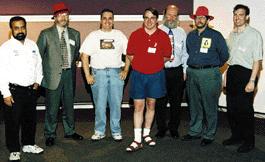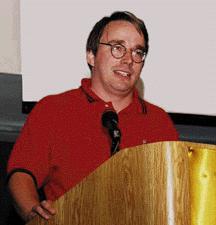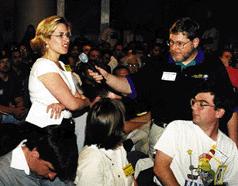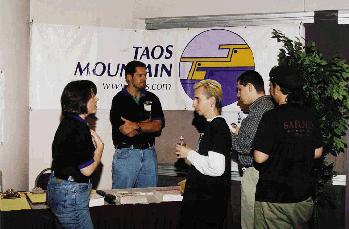

An informal report on the panel discussion held in Santa Clara on July 14.

The Future of Linux was set up as a panel discussion and was held at the Santa Clara Convention Center (in the heart of Silicon Valley) on the evening of July 14, 1998. It was hosted by Taos Mountain and the Silicon Valley Linux Users Group (SVLUG), and was sponsored by them, Intel, Red Hat, Linux Journal and VA Research. Apparently it was considerably more popular than Taos expected; people stood in line for up to an hour to register, and the free food and free VA Research/Linux T-shirts ran out. I didn't get a firm count, but Taos said 850 people had returned their RSVP, and my estimate is 700 to 900 attended.

Linus Torvalds and the Panel
The panel was a distinguished group: Jeremy Allison, one of the lead Samba developers; Larry Augustin, founder of VA Research and member of the Linux International Board of Directors; Robert Hart, from Red Hat Software; Sunil Saxena, from Intel's UNIX Performance Lab; and, of course, The Man himself, Linus Torvalds. (While I know there are a lot of Linux fans who like to pronounce “Linux” with a long “i” sound (LYE-nucks), and despite the fact that Linus himself doesn't care how anyone else pronounces it, he unquestionably did so with a short “i” as in “linen” (LINN-ucks). In Swedish he presumably still pronounces it the third way, roughly “LEE-nooks.”) The discussion was moderated by Michael Masterson of Taos, who traded off questioning duties with Phil Hughes, all-around hairy guy and publisher of Linux Journal.



Linus Torvalds responds to a question from the audience. Ben Spade, president of the Silicon Valley Linux User Group, serves as microphone wrangler.
I did not have a tape recorder, so answers are paraphrases of what was actually said. [Comments in square brackets are my personal asides.]
1. How much bigger will the Linux market be in 2000?
Jeremy Allison said 20% to 25% of shipping Intel systems will have Linux pre-installed.
Linus Torvalds said that he's always been bad at predicting things and basically weaseled out of answering the question.
Sunil Saxena also declined to speculate.
Larry Augustin said that Linux would be the #1 UNIX by 2000.
Robert Hart mentioned the Datapro report that showed only two operating systems increased their corporate market share in 1997; Linux was one of them. He said the doubling time was 12 months, which would imply between 20 million and 40 million Linux users; “I'll be surprised if we don't go beyond that.”
2. World domination: how much longer? [in reference to Linus' rather famous stated goal in his .sig or .plan or something]
Linus Torvalds: “That used to be a joke... [much laughter] ...and it's becoming less and less so.” He said his ego hopes it will happen in five to ten years; but more realistically, he hopes that in five to ten years no one dominates the industry.
3. What is Samba's role in Linux's acceptance?
Jeremy Allison first asked for a show of hands; it appeared that roughly 40% of the audience used Samba. Then he gave the short answer to the question: Samba “essentially allows people to remove NT servers.” He noted that SGI is officially adopting Samba [recall that they, like HP, are now selling NT systems as the low end of their product line] and that “some crazy folks are running it straight off of CDs with 200 users” (mostly universities who “do not want NT”). By the end of the year, he hopes that Samba will be able to completely replace all primary NT Server functions.
4. Open Source is obviously just another fad—isn't it?
Larry Augustin was the first to disagree; he said that Open Source is here to stay—for example, it allows a company like Netscape to compete on its own terms with Microsoft, not on Microsoft's terms. It also supports a Darwinian model: if one vendor's support is lacking, you've got the source and can take your money (and business) elsewhere. That's not possible with the closed-source model epitomized by Microsoft.
Robert Hart expanded on that point: it's all about control. If you need a new feature or bug fix or other customization, you can simply hire someone to do it for you. “You don't need anyone's permission; just do it!” I believe he related an example of a company with a large application that was in dire need of a bug fix; they were willing to spend essentially any amount of money or manpower to get the thing working, but their vendor was unresponsive and they had no real alternatives.
Jeremy Allison claimed that he was fundamentally “a lazy programmer” and that the Open Source model is a way of letting users do the work [more laughter]. He mentioned that some incredible Samba patches occasionally turn up in his e-mail—often oddball customizations useful to only a few people, but to them they're extremely useful. “Imagine asking Microsoft to do a custom NT Server for your site.”
5. What will be the long-term effects on Linux of Microsoft's recent win against Netscape (i.e., bundling MSIE in Win98)?
Linus Torvalds dismissed the Department of Justice and the U.S. legal system as important factors in Linux's future; “the only thing that will matter is the market.” In fact, he claimed it's an advantage since there are many companies who find it hard to compete, when Microsoft sees what they're doing and simply incorporates similar technology directly into the OS. In the Linux arena they can find a niche and compete (echoing Larry's comments above), as Corel has, for example. “That's one reason why, in the end, a monopoly just doesn't work. [pause] Maybe that's just me...”
6. What do we need to do to get applications (such as from Adobe and Quark, which are the only non-Linux applications used by Linux Journal), ported to Linux?
Robert Hart said there are just two things: let them know you want Linux ports, and show them there's profit to be made.
Larry Augustin related an article seen on Slashdot earlier in the day about Informix's unannounced Linux port and said the key is to tell vendors, “If you port it to Linux, we will buy it.” [Three days later, Slashdot and InfoWorld Electric reported a sudden reversal of plans at Oracle: they will be porting Oracle 8 to Linux after all. In fact, they say they've had it running internally for a while already. See also InfoWorld Electric's article on Informix's official Linux announcement, made on July 22.]
7. With regard to the Linux Standard Base (a standard for base-level compatibility across Linux distributions): Red Hat and Debian's standard package formats, Red Hat's early adoption of glibc vs. everyone else, etc., are we doing this right? Are there too many Linux “standards”?
Robert Hart had three points in response. First, a lot of discussion goes on between the various distribution makers, precisely for the purpose of avoiding fragmentation. Second, we have a danger of stultifying and crushing the rapid pace of development and the incredible customization choices available to users if we have too much rigidity and standardization. Third, to the other distributions: “Please get with it—glibc is the only actively maintained C library.”
Larry Augustin countered that he's seen a lot of users who, when they upgraded to Red Hat 5.x, found that “everything broke”. [Thanks to Jason Riedy for the reminder that just installing the older libc 5.4.x somewhere in the library path isn't sufficient; most shared libraries used by older applications need to be duplicated, as was the case in the changeover from a.out to ELF binaries a couple of years ago.] “You're in the big time now. Some things (like Informix) users can't simply recompile—try to make things easier for people and remain compatible.”
8. What if Microsoft plays the Linux game? For example, Open Windows 99 or Internet Explorer for Linux?
Linus Torvalds first noted that he's working at a company [Transmeta] whose product won't be available on the Internet. He went on to say that he has a lot of respect for Microsoft's PR machine, and “let's hope they do.”
Jeremy Allison apparently interpreted “Open Windows 99” as a hypothetical Microsoft release based on Linux, and said he would welcome MS Linux—the GNU General Public License (GPL) limits abuse. “If they change it, we'd get the source code,” to which Linus muttered, “We could fix it, too.” [much applause and laughter]
9. NASA, NIST, the U.S. Postal Service, the IRS all use Linux—is the U.S. Government the first step toward world domination?
Linus Torvalds: “I hadn't really thought of that, but now that you've planted the idea...” [more chuckles]
Is Linux superior, comparable, or inferior to commercial operating systems? [or something like that]
Jeremy Allison (Samba): [I think he was one of the panelists who made the comment that “Linux is a commercial OS”; his answer amounted to choice #1:]
Linux is very standards-compliant (e.g., Posix); a good approach is to develop first on Linux, then port to a proprietary UNIX system. For example, Samba has three separate pieces of code to deal with some aspect of file-system stuff; Linux supports all three interfaces, so they just choose the one that runs the fastest.
He gave a wish list of improvements he'd like to see, though: 64-bit file-system support (“for those 20GB Exchange databases”); access control list (ACL) support; asynchronous I/O support; NFS file-locking and improved performance [amen to that]; and a thread model like Solaris.
He noted that Linux has current support for more platforms than any other OS: x86, SPARC, Alpha, Power PC, 68k, etc. Bugs are fixed the fastest, especially security leaks.
There's been a Linux “iBCS” module to support SCO UNIX binaries for a couple of years; at this year's USENIX, SCO announced (and demoed) a module to run Linux applications.
Larry Augustin (VA Research): His answer was “yes”. Linux is not (yet) as far along as Solaris in supporting 64-way symmetric multi-processing (SMP). [I thought the SPARC-based Fujitsu AP1000+ on which David S. Miller reported success last year was a big SMP box, but as Jason Riedy pointed out, it's a distributed-memory multi-computer similar to the Connection Machine CM5.]
In his slides of user ratings (Datapro survey, which was mentioned several times during the evening), Linux was not only the overall winner in a field of half a dozen operating systems (Windows NT placed last), it also won in all but two categories—and only Digital UNIX was rated higher in those two (availability and performance). The other categories included reliability, technical support, price, etc.
Robert Hart (Red Hat): Linux is a commercial operating system. It is sold and supported commercially (Red Hat, Caldera and others); it is used commercially; its only difference is that the source code is freely available.
Key “commercial OS” features like a journaling file system and database access that bypasses the file system layer are coming very soon.
Many of Red Hat's users (more with every release) have never installed an OS, which means Red Hat has to “reverse engineer” their hardware configuration.
Why is Linux not ubiquitous? It's still not suitable for everyone (he mentioned his “75-year-old mum”), and although there are good office applications for Linux, there aren't any killer ones yet. (There were follow-ups to the suitability comment by some of the other panelists.)
Sunil Saxena (Intel): He presented some slides that amounted to a “yes” response as well.
Strengths: Linux is becoming the OS of choice of ISPs; on 32-bit Intel systems, Linux has broader device-driver support than any other UNIX (e.g., SCO, Solaris/x86, etc.); its Open Source model means that updates, patches and bug fixes happen in “Internet time.”
Weaknesses: SMP support and scalability is still evolving (although he noted that Leonard Zubkoff did a successful two-day port to the brand-new, four-way Pentium II Xeon system that Intel and VA Research showed off); good server management is missing (e.g., using a remote serial line or modem to update things, including the BIOS); drivers for high-end hardware tend to be lacking; and large-memory support (say, multi-gigabyte range) isn't there.
Making it better: he said (and repeated several times throughout the evening) that Intel really wants to help and do more to support Linux, and in particular, they see the following as likely areas of collaboration:
more than 4-way SMP (serious scalability, at least 16 to 32 processors)
drivers for high-end platforms
direct server control and management
support for PII features such as 36-bit addressing (up to 64 GB of RAM), enhanced system calls and save/restore, MMX instructions, the page attribute table, and on-chip performance monitors
Linus Torvalds: He started off with a comment to the effect of, “What can I say? I came to listen to the others.”
He noted that Linux originally was a one-person OS; it was never intended to be useful to others. He also pointed out that it has just shown up on the list of the world's most powerful supercomputers (in a cluster design); he thought it made #316. [Actually #315 in the June 1998 list—see the press release for details.] At the other end of the spectrum, it's being ported to Palm Pilots. “I don't see that [its broad portability and usefulness] ending any time soon.”
He responded to a couple of Sunil's comments:
36-bit addressing on Intel: “We've been doing that on Alpha for awhile.”
Page Attribute Table: he didn't know about Intel's implementation but said that he'd suggested it to an Intel engineer a few years ago; “I don't know if they did it right, but if so, I'll be happy to use it.”
Where will Linux be in two to three years?
Sunil Saxena: “It's all on my foil right here.” Among Internets/Intranets/ISPs, Linux will continue to grow, especially in corporate America; we'll see continued adoption.
There will be new growth in the areas of E-commerce and business-to-business Internet EDI (electronic data interchange).
It will start showing up in all sorts of Internet appliances, including wearable computers, video-conferencing systems, etc.
We'll see 64-bit Linux on the IA-64 (Merced).
Linux will move into the data center via high-availability clusters and 16- to 32-way SMP systems.
Other spiffy features like I2O, hot swap, serial-based server management and control, etc., will be supported.
Linux developers will be granted early access and increased access to specs and Intel engineers.
“Please come talk to us and tell us what we can do.”
Larry Augustin: One big prediction: kernel 2.2 will be released within three years (“and that's pushing it”). [much laughter]
He also took the opportunity to thank Leonard Zubkoff for the four-way Xeon port being demoed by VA Research in the rear. Apparently he modified (added?) 20 lines of code at the last minute without even having all of the source there.
Robert Hart: Two to three years is an eternity for Linux—even a week is a long time.
People are lazy, and laziness leads to creativity, which means great improvements for Linux.
He again noted that it's the only non-MS operating system to gain market share and that it's being actively courted by large vendors such as Intel. He also noted that it's generating strong media interest, and not only that, but the reporting is generally both accurate and useful. (He thanked the representatives of the press in the audience.)

All photographs used with this article are by Jim Howell, courtesy of Taos Mountain.
There will be a strong showing of easy-to-use applications.
Linux will be the dominant server platform, not just on Intel but across all platforms. I believe he mentioned “64-bit, 4-way Merced,” too.
He mentioned that it was Bastille Day and recalled how, in 1788 and 1789, the people rose up and stormed the IT department and gave freedom to oppressed machines. “They even executed some people.” But he disputed his own comparison and said that Linux isn't so much a revolution as an evolution; it didn't happen just once.
He concluded by predicting that in two to three years, Linux will be “very nearly everywhere”.
Linus Torvalds: “I'm really bad at predictions.” For example, a few years ago when he was asked about SMP support, his reaction was, “I don't know, it's too expensive”; he said he didn't care much about it and didn't find it interesting. But for the last year he's worked almost exclusively on SMP.
2.2 will be out by then. [much more laughter]
The kernel is really just a vessel for what one can do; he claimed that it was inappropriate to ask him such a question—“what's really exciting is applications” (and the journaling file system is “slightly exciting”).
Servers will be big. [Do we sense a theme here?]
The interesting part will be “pretty” applications that traditionally haven't been UNIX-based.
Jeremy Allison: He used to keep track of every minor release of every piece of free software; these days, no one can do so for even 10% of it, and there will be some incredibly cool things in that other 90%.
Linux will be a “killer server platform.”
Everyone at Cisco Systems uses Linux every time they print, whether they know it or not. [See the c.o.l.a announcement for details about the printer-administration tool used at Cisco, and the article about Cisco in this issue.]
At least one major PC vendor will start shipping PCs with Linux pre-installed. (If not, Robert will start such a company.)
With regard to applications, vendors are already “not as greedy” as they've traditionally been on UNIX systems; Linux applications are priced similarly to Wintel applications, not five times more. Linux will be on the desktop, and one will be able to buy almost any application for Linux.
Again, he predicted that Linux will be installed on 20% to 25% of shipping Intel systems.